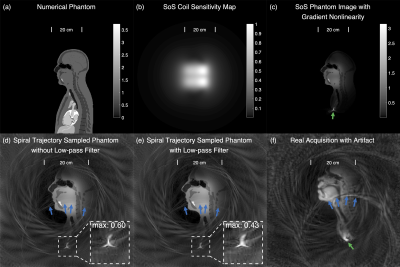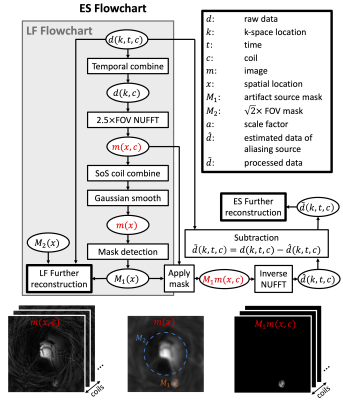Ye Tian1, Yongwan Lim1, Ziwei Zhao1, Dani Byrd2, Shrikanth Narayanan1,2, and Krishna S. Nayak1
1Ming Hsieh Department of Electrical and Computer Engineering, University of Southern California, Los Angeles, CA, United States, 2Department of Linguistics, University of Southern California, Los Angeles, CA, United States
1Ming Hsieh Department of Electrical and Computer Engineering, University of Southern California, Los Angeles, CA, United States, 2Department of Linguistics, University of Southern California, Los Angeles, CA, United States
We present and evaluate two methods that mitigate a common artifact in mid-sagittal spiral MRI of speech production, arising from gradient nonlinearity and an ineffective anti-aliasing filter.

Figure 2. Illustration of spiral aliasing artifacts in a numeric phantom and in-vivo. The numeric phantom is based on XCAT with SPGR contrast (a), using simulated coil sensitivities (b), and gradient non-linearity maps of the GE Zoom coil. Simulated image shown in (c) illustrates the distortion and the hotspot outside the FOV (green arrow). Simulated spiral reconstructions without (d) and with (e) readout LPF both contain spiral aliasing artifacts within the FOV (blue arrows). This behavior closely matches in-vivo data, with a representative example shown in (f).

Figure 1. Flowcharts of artifact reduction methods. The data was temporally combined and reconstructed to 2.5×FOV to obtain coil images. Root sum-of-squares coil combination was performed, and the resulted image was smoothed. A mask M1 was automatically detected around the pixel with the highest intensity outside the FOV by thresholding. The LF method can then be performed by applying masks M1 and M2 during reconstruction. For the ES method, M1 is applied on the coil images, and k-space of the aliasing source was estimated and subtracted from the raw k-space for further processing.
